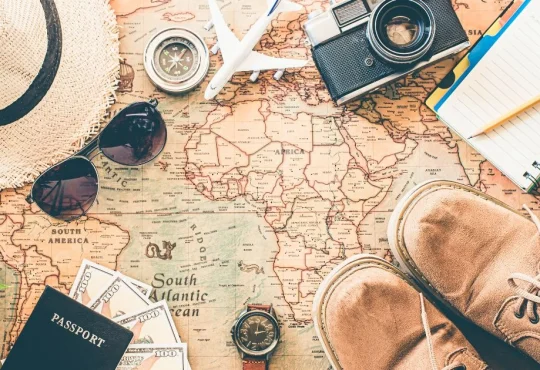Embarking on your first flight can be both exhilarating and a little nerve-wracking. To ensure a smooth journey, knowing what to do before, during, and after your flight is important. This article delves into the First Time Travellers Guide. So go ahead and read further.
First-Time Travelers Guide: Your Perfect Handbook in 2024!
What should you do when flying for the first time?
- On the airplane
Find your seat.
As you board the plane with many others, you’ll be greeted by the airline crew at the door. Depending on the type and size of the airplane, they will direct you to the appropriate aisle. If you need clarification, show them your boarding pass; they’ll assist you. The aisle is narrow, so be careful not to bump into seated passengers. Handle your luggage with care as you locate your seat.
Above the seats, you’ll see numbers and seat letters, typically labeled A, B, C, etc. These labels also indicate which seats are by the window or aisle. If you find someone sitting in your chair, it might be a mistake or an attempt to sit closer to friends or family. Inform them it’s your assigned seat, and you can sit there.
Place Your Luggage
Once you find your seat, place your luggage in the overhead cabin or under the seat in front of you. It’s highly recommended to bring a small bag with your important belongings or entertainment items to keep close by. Avoid unpacking or organizing items in the aisle, which can block other passengers. It’s best to have everything arranged before boarding. During the flight, you can access your luggage, but if you have a window seat, be mindful of not disturbing others in your row who may need to stand up each time you need something.
Now it’s time to relax. Settle into your seat, enjoy the activity around you, or start watching a movie.
Safety instructions
Once the doors are closed, the flight crew will present the safety instructions in person or via a video on your screen. Additionally, you will find a safety card with detailed instructions in front of your seat. These guidelines cover important procedures, such as using seatbelts, the operation of life vests and oxygen masks in emergencies, and locating and using emergency exits. Pay attention to these instructions for safety. Be cautious when opening overhead luggage compartments, as items may have shifted during the flight and could fall out due to turbulence.
If you are seated in an exit row, be aware of your responsibilities regarding the emergency door. The use of electronics will also be covered in the safety briefing. For a preview, you can watch an in-flight safety demonstration video. Remember, flying is a very safe mode of transportation, and the crew is extensively trained to ensure your safety and manage any situation that may arise.
Before takeoff, familiarize yourself with airport procedures and pack essentials in your carry-on. During the flight, stay comfortable by following in-flight instructions and keeping yourself entertained. After landing, navigate the arrival process efficiently and plan your next steps. With some preparation, your first flying experience can be enjoyable and stress-free.
- Takeoff
Takeoff is an exhilarating part of your first flying experience. As the airplane prepares on the runway, you’ll hear the engines powering up and feel the increasing speed. The nose of the plane will lift, and you might feel a gentle push into your seat, but it’s not uncomfortable. Taking off can be daunting, but enjoy the ride, especially if you have a window seat. Watching the world shrink beneath you is a unique and captivating sight.
During ascent, you might experience a few bumps due to wind and a brief sensation of descending, which is perfectly normal and marks the end of the climb. And just like that, you’re soaring high in the sky on your first flight! Enjoy the view and the thrill of being airborne for the first time.
Food and Drinks
Food and drinks on flights can vary significantly depending on the airline and type of flight. Low-cost carriers typically do not include complimentary food and beverages, but you can purchase snacks on board. The kind of food served on flights where meals are included often depends on the destination and flight times. For instance, you might receive breakfast, lunch, and dinner. When flying from Amsterdam to South Korea with Korean Airlines, you might enjoy traditional Korean cuisine, whereas the return flight with KLM might serve pasta. You can also request special meals, such as vegetarian or halal options, during booking or via your online profile.
Overall, the quality of in-flight food can vary. While we were generally satisfied with our meals, we had an experience with Air France where breakfast was not served on a night flight, highlighting the importance of bringing snacks. Packing filling snacks or treats like chocolate can enhance your in-flight experience. Note that you cannot bring drinks from home due to the 100ml liquid limit in hand luggage, so buying a bottle of water at the airport is a good idea before boarding.
Toilet
Airplanes typically have toilets towards the front and back, depending on the aircraft type. Generally, you can use the restroom throughout the flight, except during takeoff, landing, and when the seatbelt sign is illuminated, often due to turbulence. It’s noteworthy that using the restroom during turbulence can be challenging – speaking from experience.
The crew regularly cleans the toilets, but the confined space can still make them uncomfortable. You can flush the toilet and wash your hands as usual. Before heading to the restroom, checking if others are waiting is courteous, especially since standing in the aisle can inconvenience nearby passengers. Additionally, handling necessary bathroom needs before boarding is a good idea to avoid discomfort for yourself and fellow passengers.
Comfort on the airplane
Comfort on the airplane is essential for a pleasant flight experience. You can recline your seat for a more relaxed position, which is especially helpful when trying to sleep. While some may hesitate out of consideration for the person behind them, reclining is a standard feature everyone can use. Comfort is particularly valued on long-haul flights, making reclining a practical option.
Regarding convenience, there isn’t a trash bin conveniently located near your seat. After receiving in-flight meals, you may need to wait until everyone is served before the crew collects trash. This wait can sometimes be inconvenient despite understanding the necessity. It means having a full tray table in front of you for a while, which reduces your immediate space until the crew comes around to clear it.
What activities can you engage in during your flight?
Walk Around
Walking around during your flight is beneficial for stretching your legs and improving blood circulation. However, timing is key, as moving around in the aisle can obstruct the crew’s tasks. Be mindful of their movements and choose appropriate moments to stretch your legs.
The availability of in-flight entertainment varies depending on the airline and aircraft. Some flights offer personal TV screens where you can enjoy various movies, music, games, and more. Bringing your earplugs is recommended for better comfort, although airlines often provide them to passengers, which may only sometimes be the most comfortable option.
Landing
As the flight nears its destination, usually about 40 minutes to half an hour before landing, you’ll feel a slight decrease in speed and a change in cabin pressure as the aircraft begins its descent. This gradual descent is a reassuring signal that we’re preparing to land, which I always find exciting!
The cabin crew will provide updates and instructions to prepare for landing, including returning seats and tray tables to their upright positions. You’ll sense the aircraft lowering closer to the ground, and soon, you’ll hear the landing gear deploying with a characteristic noise, followed shortly by a gentle bump as the wheels touch down on the runway. This marks the conclusion of your first flight experience—we hope you enjoyed the journey!
- Upon arrival at your destination
Follow the airline crew’s instructions
When it’s time to leave the airplane, it’s essential to follow the airline crew’s instructions and remain seated until they give the signal, typically after the aircraft has reached the gate at the airport. Upon arrival at the gate, you may observe a mix of passengers feeling eager and impatient to disembark. People often gather their belongings, turn on their phones, and prepare to retrieve luggage from the overhead compartments, sometimes crowding the aisles in anticipation of leaving as soon as possible.
However, disembarking can only commence once the crew opens the doors and provides clearance. It’s advisable to remain relaxed and patient during this time, as everyone onboard will eventually be able to exit. Unless you have a pressing need, such as catching a connecting flight, it’s generally best to wait calmly in your seat or politely ask the crew for assistance if necessary. This approach ensures a smooth and orderly disembarkation process for all passengers.
Proceed towards the Exit Signs
After arriving at your destination, proceed towards the exit signs and follow directions to the baggage claim area. Check the display screens to confirm the status of luggage arrivals and locate the designated baggage carousel for your flight. Once at the carousel, ensure you retrieve only your luggage by identifying it with distinctive markings or a personalized label containing your contact details in case of loss. Be patient if your luggage does not immediately appear on the carousel; luggage is typically unloaded in batches, especially on larger flights, and will eventually be released individually.
It’s important to remain calm and allow the baggage handling process to unfold naturally. If you encounter any issues or concerns about your luggage, airport staff are available to assist you. Staying organized and patient allows you to navigate the baggage claim process smoothly and efficiently upon arrival.
Proceed through Immigration
Upon arrival at your destination, you will likely proceed through immigration, where an officer will verify your identification and visa status if necessary. Depending on the volume of travelers, queues at immigration can occasionally be lengthy. It’s advisable to gauge the line’s pace upon arrival; if it’s moving quickly, proceed promptly, or if it’s congested, consider taking a brief restroom break to avoid unnecessary waiting.
Navigating immigration smoothly involves having your documents readily accessible and following any instructions from airport personnel. By preparing beforehand and being patient during peak periods, you can streamline your entry process into the country and minimize any potential delays.
Conclusion:
We hope your first flying experience was fantastic! We trust that these first-time flying tips were helpful to you. Flying opens up a whole new world of adventures, and you may find yourself eager to book your next flight before long. It’s common for flying to become addictive as you explore new destinations and experiences. Enjoy the journey ahead!





